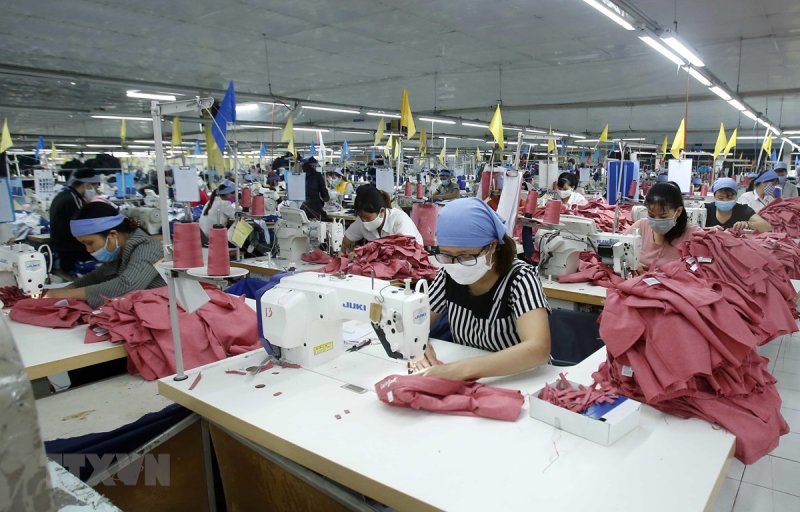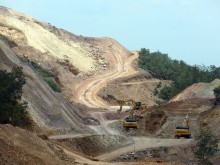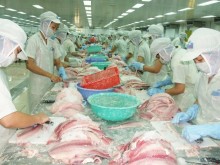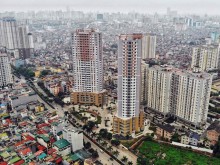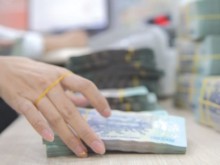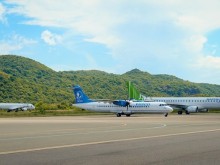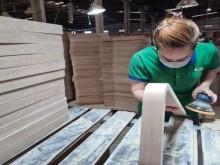Vietnam is among the destinations receiving huge investment shifts from China and has taken the lead in the race for FDI capital against potential competitors such as China, Indonesia, India, and Mexico. However, the country still finds it difficult to attract FDI due to international political instability and domestic investment barriers.
Foreign investment in Vietnam reached US$27.72 billion in 2022, with year-on-year increases of 12.2% in newly-registered projects and 12.4% in adjusted investment capital, according to the Foreign Investment Agency under the Ministry of Planning and Investment. Notably, many large-scale production and high-tech electronics projects received large additional capital, such as Samsung’s expansion in Thai Nguyen and LEGO’s US$1 billion investment in a Binh Duong factory.
These have reaffirmed foreign investors’ confidence in Vietnam’s economy and investment environment. However, there are still many things to be done to make FDI inflows sustainable, as stated in Vietnam’s recent economic and social development strategy.
Less attractive
“Vietnam: Rising star in the global supply chain” and “Vietnam: New destination in supply chain diversification” are what Ngo Van Giang, deputy director of the Academy of Policy and Development, underlined at a recent workshop on connecting industries in the northern region.
Vietnam’s bilateral economic relations with over 230 countries and territories, the signing of 17 free trade agreements (FTAs), and approval of the EVIPA helped create a solid legal basis and platform for Vietnam’s deep and wide integration into the world economy and participation in global value chains. With its geographical location as a bridge between the maritime and continental economies of Southeast Asian and Asian countries, Vietnam has become a bright spot in attracting FDI inflows and for the first time, entered the group of 20 leading countries in the world for FDI attraction in 2020.
Additionally, Vietnam is among the destinations receiving huge investment shifts from China and has taken the lead in the race for FDI capital against potential competitors such as China, Indonesia, India, and Mexico. However, Vietnam still finds it difficult to attract FDI due to global geopolitical tensions and domestic investment barriers.
Nguyen Dinh Nam, chairman of Vietnam Investment Promotion and Associates Corporation (IPA Vietnam), stated that the majority of the US$12.45 billion in newly registered capital in 2022 came from large-scale existing FDI enterprises and their activities, such as capital expansion, capital contribution and production expansion.
In other words, the large FDI inflows Vietnam has received in recent years mainly come from the recovery and expansion of long-term investors in the country instead of new ones, Nam said.
The total registered FDI in Vietnam, including newly registered capital, adjusted registered capital, capital contribution and the share purchase value of foreign investors, reached US$1.69 billion from the beginning of 2023 to January 20, 2023, down 19.8% compared to the same period last year, according to the General Statistics Office.
Realized FDI in Vietnam was estimated to reach US$1.35 billion in January 2023, down 16.3% year-on-year. In addition, many FDI businesses have announced mass layoffs. “It shows the negative impacts of the global economic downturn on investment activity in Vietnam,” Nam said.
The slowing FDI recovery was attributed to the Russia-Ukraine conflict, the lack of business and investment confidence, production and trade disruptions, high inflation and the negative impacts of the Covid-19 pandemic, Nam explained.
Moreover, several prominent economies are actively incentivizing and facilitating the return of production and foreign investment to their home countries. One such example is the U.S., which has implemented measures such as slashing the income tax rate from 25% to 21%, simplifying investment licensing procedures and implementing more adaptable standards to boost the competitiveness of key industries such as energy, automotive, aluminum and steel.
The EU countries have pursued a “strategic autonomy” by regulating outbound investment capital. For instance, Germany and Italy have implemented stricter controls on FDI in strategic sectors. In Asia, Japan has earmarked a budget of US$2.2 billion to support Japanese businesses in moving their production networks from China back to Japan and other third countries, focusing on sectors such as medical equipment, auto parts and electronics.
Moreover, the competition to attract FDI among countries in the Southeast Asia region is gradually heating up since Indonesia issued new incentives to welcome foreign investors, including reducing corporate income tax to about 22-25% in 2020 and further reducing it to 20% in 2022. The country also set aside a 4,000-hectare area to develop new industrial parks.
Meanwhile, Thailand has also aggressively attracted investment in the medical equipment sector. It prioritizes high-tech projects with a 50% reduction in corporate income tax for three years and promises to support them in developing human resources.
“Given the high competitiveness between countries in Southeast Asia, whether Vietnam can retain large companies such as Samsung in Vietnam for the long term depends heavily on its investment incentives, which help reduce production and business costs,” Nam said.
Foreign investors encounter difficulties when visiting Vietnam. One example is that residents of certain countries holding a Vietnam business visa are entitled to a stay of 15-20 days. This short stay is not enough for investors to survey the investment and business environment in different parts of Vietnam.
“Some investors have to return home to apply for a visa after surveying the northern region as they want another survey in southern provinces. This wastes a lot of their time,” Nam explained.
Moreover, the rapid escalation of industrial park land prices in recent years has also influenced the investment decisions of foreign investors. According to a CBRE survey, the average rental price for industrial land in first-tier markets in the north was around US$120 per square meter per term at the end of 2022, up 11% over the figure in 2021.
Notably, certain industrial parks in Bac Ninh and Hung Yen saw a significant increase in rental prices as the leased capacity improved, resulting in the highest rental price growth in the market in the last five years, with an annual increase of around 6-7%.
By the end of 2022, the average land rental price in the first-tier markets of the southern region surged to US$166 per square meter per term, representing a year-on-year increase of 8-13% and about 38% higher than the average rate in the northern region.
“One of our clients surveyed the Vietnamese market carefully, then ended up choosing Indonesia due to its large areas of available land at industrial parks and slow rent rises,” Nam said. Investment promotion agencies must spend time and effort to persuade investors.
Lawyer Bui Van Thanh, head of New Sun Law Firm’s Office, stated that a group of clients from Singapore, Taiwan and China, primarily Mandarin-speaking people, faced significant challenges due to inconsistent explanations and application of laws and policies across different localities.
For instance, a foreign company can easily develop a US$250-million project in Hai Phong but has difficulty implementing another with US$200,000 in Hanoi due to a lack of investment registration documents.
Additionally, there remain differences in the interpretation and application of regulations regarding customs supervision, taxation and the registration of export processing enterprises across various regions.
For providing electricity to export processing enterprises, Party B (the export processing enterprise) can enjoy a 0% value-added tax policy, while Party A (the service provider) is required to comply with the legal provisions based on the written confirmation of the tax agency. Party B has to send it to Party A for invoicing and settling taxes with Vietnam’s state tax management agency.
According to Thanh, this situation raises concerns about the legal safety of investing in Vietnam for many companies.
Consistency in mindset and actions to attract FDI
For Vietnam to become an ideal destination for large enterprises, the Government should apply various investment policies and focus on maximizing the benefits of foreign investment to attract FDI to help restore the economy.

However, the policies have to ensure the nation’s interests, promote production and improve domestic capacity instead of just maximizing the amount of capital to attract foreign investment.
Additionally, the application of screening mechanisms can hinder the attraction of FDI inflows.
Therefore, FDI inflows should only be limited to certain sectors, usually national security-related ones. Moreover, Nam warned that the overuse of land and tax incentives to compete for FDI could cause developing countries to fall into a “race to the bottom” competition.
Lawyer Bui Van Thanh proposed four principles of conduct with foreign investors, including clear, understandable and easy-to-apply legal provisions; simple procedures; quick implementation in investment projects and taking advantage of investment incentives; transparent and quick resolution methods to deal with conflicts.
Taiwan, one of the 10 economies with the most FDI in Vietnam, has established 14 Taiwanese merchant associations in the country for regular meetings to discuss the conduct of the Vietnamese Government, industrial park developers, contractors, and investors, according to Thanh.
“Any bad behavior will immediately be known in the Chinese-speaking community and even worldwide,” Thanh said. Regarding the industrial park developers, the management board and the investment consulting and brokerage units need to build a close cooperation relationship and share the same message on the investment conditions in Vietnam, according to Tran Thi Huyen, senior business manager of Deep C Industrial Park.
In addition, it is necessary to carefully update the needs of investors in terms of rental costs, geographical location, environmental pollution treatment system and human resources.
“International investors will have at least one analysis and overview of the investment environment in different localities in Vietnam when returning to their home countries. It also lays the basis for them to make good or bad reviews about the locality and the industrial park,” Huyen said.
Moreover, the investment consulting and brokerage units should make further efforts to grasp the requirements of investors and authorities to provide appropriate advice and minimize the issuance time of investment certificates. “Information about the availability of land at the industrial parks and their utilities should be clarified so that investors do not have to wait for land after receiving investment certificates,” Huyen said.
